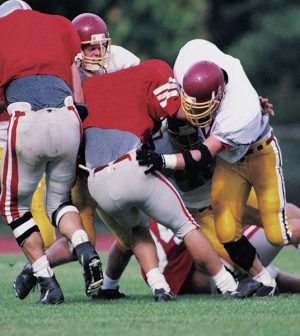- Understanding the Connection Between Anxiety and Depression
- How Daily Prunes Can Influence Cholesterol and Inflammation
- When to Take B12 for Better Absorption and Energy
- Epsom Salts: Health Benefits and Uses
- See What Saffron Can Do for Sleep and Heart Health
- 6 Common Mistakes to Avoid Before Your Physical
- Can Sweating Really Help You Beat a Cold?
- Strengthening Your Relationship: Practical Strategies
- Skip Storing This Everyday Product in the Fridge Door
- Green Tea + B3 Pairing May Boost Brain Health
Concussions More Likely in Practice Than Play for College Football Players

College football players suffer more concussions and head hits in practice than they do actually playing the game, a new study suggests.
Across five seasons of football, 72% of concussions and 67% of head impacts incurred by players on six National Collegiate Athletic Association (NCAA) Division I teams happened during practice rather than on game day, researchers found.
The incidence of concussion and head impacts also were disproportionately higher in the preseason than the regular season, said lead researcher Michael McCrea, director of the Brain Injury Research Program at the Medical College of Wisconsin in Milwaukee.
“Our data suggest modifying preseason training activities and football practice throughout the season could lead to a substantial reduction in overall concussion incidence and head impact exposure,” McCrea said. The findings were published Feb. 1 in the journal JAMA Neurology.
While these specific findings are new, experts and coaches have known for years that practice is at least as dangerous as actual play when it comes to head trauma, said Dr. Robert Cantu, medical director and director of clinical research at the Cantu Concussion Center at Emerson Hospital in Concord, Mass.
That’s why the National Football League agreed in 2015 to dramatically reduce full-contact practices in its collective bargaining agreement with the NFL Players Association, said Cantu, who wrote an editorial accompanying the new study.
The NFL now has only 14 full-contact practices in the course of an 18-week season, and none at all in the off-season, Cantu said.
“It was known from previous studies and from what the NFL did that if you wanted to significantly reduce the amount of contact, especially to the head, you would alter the way you practice,” Cantu said.
But college football has been less clear on this issue, so the new study, funded in part by the NCAA, could help inform future practice guidelines.
“The NCAA and its members have supported this monumental study to help answer many of the questions around the diagnosis, treatment and prevention of concussions,” NCAA President Mark Emmert said in a statement. “These latest findings provide new information for our members to modify rules while continuing education efforts for college athletes across the country.”
According to NCAA Chief Medical Officer Dr. Brian Hainline, the findings “will not only arm physicians and scientists with even better data on the prevalence and mechanisms of concussion and head impact exposure outside of regular-season play, but also shed light on the importance of better prevention and protection methods.”
But Cantu noted that the findings weren’t exactly a surprise.
“I’m disappointed that this comes out and it seems like something new to a fair number of individuals,” Cantu said. “I realize that change takes time, but for the NCAA to think they didn’t know about this five-plus years ago is crazy.”
In the new study, McCrea and his colleagues recorded more than 528,000 head impacts in 658 college football players in seasons running from 2015 to 2019. The players wore helmets rigged with accelerometers that registered hard hits to the head.
By the end of the 2019 season, players sustained an average of 415 recorded head impacts per season and 68 players had been diagnosed with a concussion.
Researchers found that total head impacts in the preseason occurred at twice the proportion of the regular season
Even within the regular season, total head impacts in practices were 84% higher than in games.
Research has found that the risk of chronic traumatic encephalopathy (CTE) — the brain injury associated with repeated head traumas — “is most tied to total number of hits to the head and not tied to the number of recorded concussions,” Cantu said.
“Concussions count, of course, but what’s even more important are all those thousands of hits to the head,” Cantu said.
It makes sense that practices would yield more head injuries than actual games because they occur more often and involve more of the team’s players, Cantu said.
“You’re practicing football four or five days a week and you’re playing it only one, and the number of people that actually play in the game are not as great as the number of people that practice it,” Cantu said. “Your first team plays in the game, mostly, unless it’s a blowout.”
Other college football leagues are heeding the mounting evidence related to the dangers of practice.
The Ivy League recently went to no full-contact practices once the season starts, Cantu noted, and some coaches have transitioned to full-tempo practices involving what’s called “thud” tackling.
“You wrap your hands around somebody like you’re going to tackle them, but you don’t,” Cantu said. “The whole idea was to not beat up your fellow teammates, so that come game day the players were hardly in injuries from practice.”
More information
The Concussion Legacy Foundation has more about CTE.
SOURCES: Michael McCrea, PhD, director, Brain Injury Research Program at the Medical College of Wisconsin, Milwaukee; Robert Cantu, MD, medical director and director, clinical research, Cantu Concussion Center, Emerson Hospital, Concord, Mass; JAMA Neurology, Feb. 1, 2021
Source: HealthDay
Copyright © 2026 HealthDay. All rights reserved.










